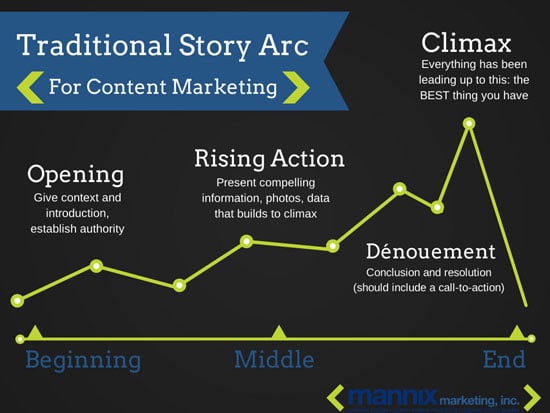I used to consider myself a writer first, a content marketer second. When I started creating visual content, however, I realized that writing and content marketing are not mutually exclusive. After exploring the visual content world, I came up with my one and only content marketing tip. To create a successful content marketing campaign – written or not – you need to do one thing that writers are very good at:
You must tell a story.
In human history, storytelling precedes the advent of the written language. Even prehistoric hunter-gatherers painted on rocks and cave walls to communicate with each other in pictures and scenes. While we’ve come a long way from cave-dwelling, even today, we value good storytellers: writers, comedians, actors, and musicians. Stories are what drive our lives forward.
Is storytelling really that important?
If storytelling is so important, why is it then, that so much of the content we see doesn’t tell a story? In the last few years, sites like Buzzfeed have created a demand for seemingly mindless content. You see list after list: 15 Cute Puppies, 28 Tasty Cupcakes, 32 Kids Falling. They’re all lists of arbitrary photos or gifs that go nowhere – and yet we all click, scroll, and sometimes even share.
Why? These lists promise to tell a story, but they inevitably fail to achieve a true story arc. The numbered titles are necessary because they promise something – they promise that the 15 Cute Puppies will culminate in that 15th CUTEST puppy, and you won’t be able to look away until you’ve seen them all. It’s a great method: there’s always the fear that if you close the window on the 14th puppy, you’ll miss out on the best one yet.
But, in a day or two these lists have already hit the bottom of your newsfeed, and it’s on to another. They don’t stick because they promise to tell a story, but they don’t. The only way for the viewer to be satisfied is to continually seek more and more similar lists. It’s the potato chip of the digital content world.
Meaningless viral stories are great short-term content for sites that can constantly generate new pieces with the help of user contribution, but these stories aren’t effective content marketing.
Nevertheless, they do tell us something incredibly valuable about true content marketing. Viral photo lists, along with other signs like the Pinterest boom and the rise of the infographic, remind us that storytelling isn’t just about writing or language. They remind us that it never was. Storytelling is about presenting a significant, interesting, or simply beautiful anecdotes in a compelling way.
What can you do?
When you create non-written content, always refer to a conventional story arc. A traditional story arc follows a plot of rising action, in which a character faces a few challenges to reach a scene of utmost intensity, after which the plot is resolved in the denouement (fancy word for conclusion). The best way to think of a story arc is to remember a classic fairy-tale, like Cinderella.
To apply a traditional story arc to your content, always open by giving the reader context and establishing your authority. Then, present your argument, data, or visual content in a way in which each piece builds on its predecessor. In the rising action phase, it’s great to surprise the viewer by providing counterarguments, like I did above. Place the most compelling pr important piece near the end of your content, and follow up with a conclusion that should reinforce the value of what you’ve created.
Modeling your content around a story arc will ensure that you’re creating significant, useful content. Create how-to guides, infographics, photo essays, videos, tweets and yes, even silly lists – but all with the story arc as the guiding principle. Generate content that drives the viewer forward and promises to culminate in a true, whole story. This way, your content will be inherently significant, relevant, and meaningful.



